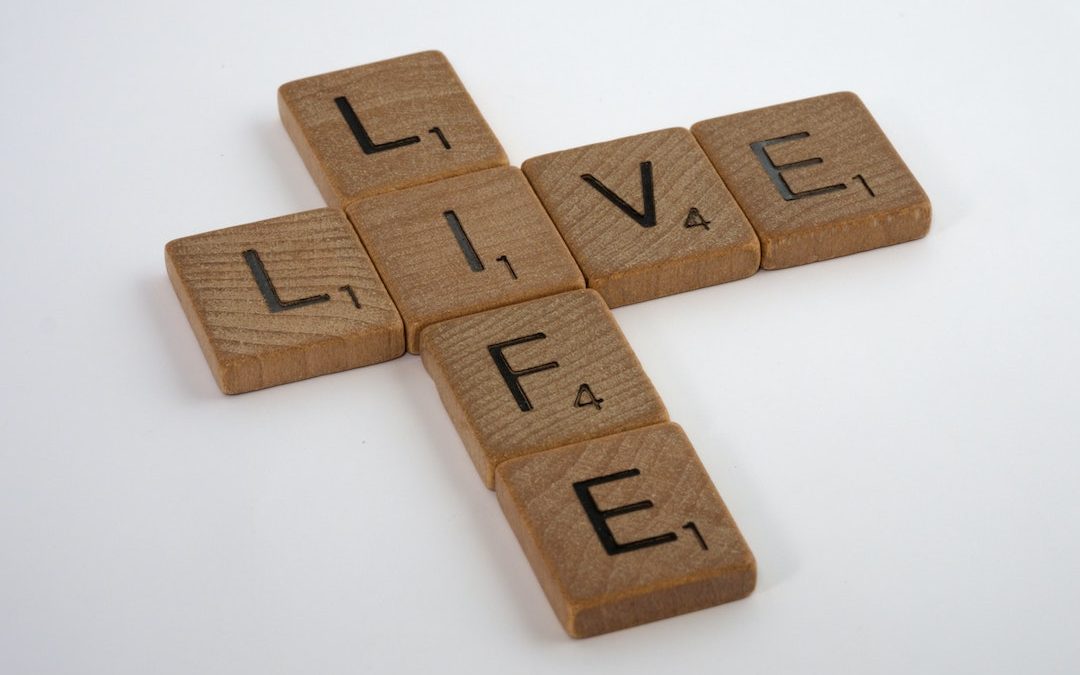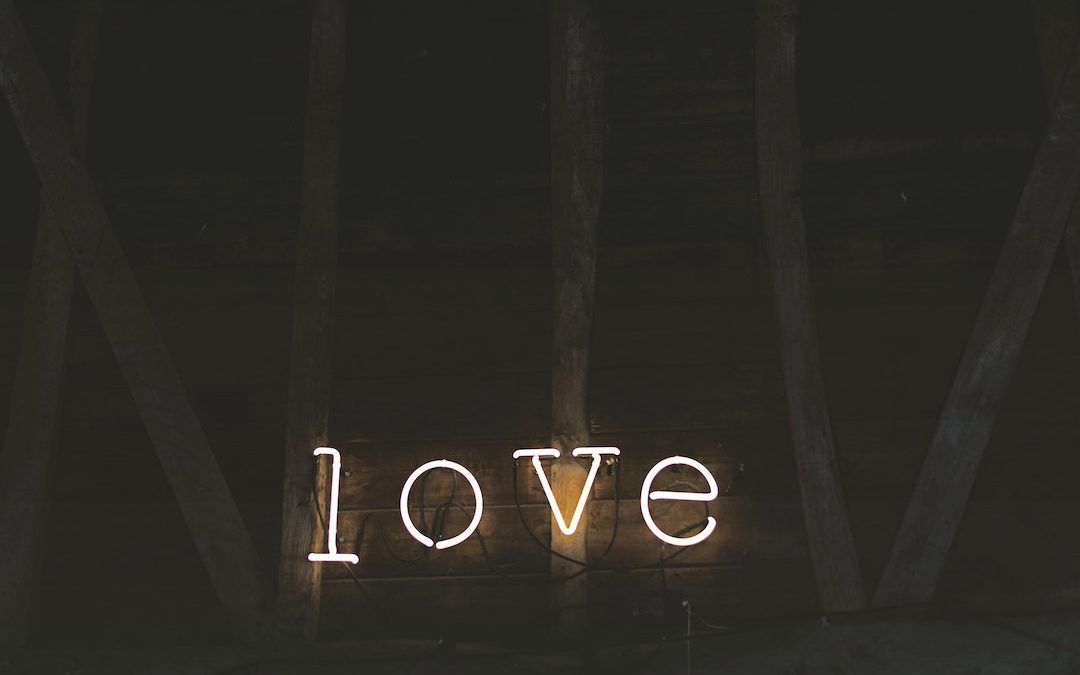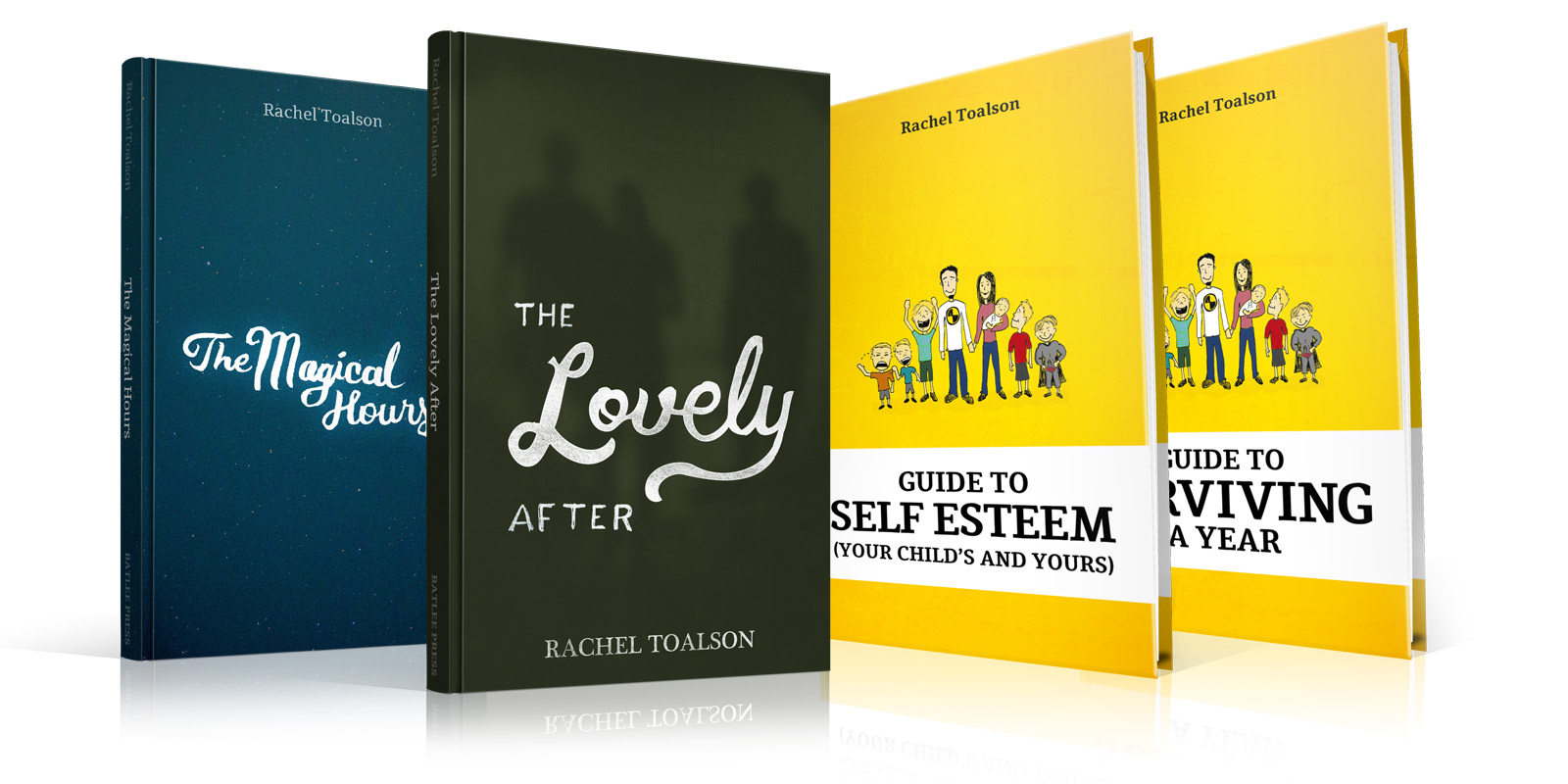
by Rachel Toalson | This Writer Life
My first book, a middle grade novel in verse, was written in tiny fifteen- or twenty-minute windows, back when my kids were very young. I had a newborn, two 3-year-olds (twins—so double trouble), a 5-year-old, a 6-year-old, an 8-year-old, and not a lot of time—obviously.
But I had a story that needed to get out, so I did what I could to jot it down between bedtime and the next newborn feeding.
When I shared this information at the book launch party for that book (The Colors of the Rain, which published in 2018), someone asked, “How do you keep a plot line going in only fifteen minutes a day?”
It’s a good question, and one that I think is probably on the minds (or in the Secret Fears Box in the brain) of many authors who don’t have hours at their disposal to write on their works in progress. Or those of us who take a while to write our books. We don’t want to rush stories. They need time and space to grow and develop.
But how do you give them the time and space they need without losing sight of where you’re going?
I’m in a different place now. I have more time to write. But there are still times when I’ve had to put aside a manuscript for weeks or even months, because of deadlines that come calling. And in a collaboration I’m working on with another author, sometimes I don’t write a chapter with my character for weeks.
How do you keep a plot line going? How do you remember who your character is? How do you make the most of the time you have, without needing to re-read everything you’ve previously written on the project?
That first book I mentioned was written, as we say in the writing world, by the seat of my pants. That means I did no brainstorming (what others call plotting). I just started writing—and the story required a LOT of revision!
Now I brainstorm (or plot) every story. It’s much easier to hold a storyline in your head for those fifteen minutes of daily writing time if you know the story already. Or if you at least have a vague path for where it’s going.
So that’s my first tip. I know it will make some writers cringe, but…
1. Brainstorm your story.
This can be whatever you make it. It can be an in-depth main character analysis followed by in depth character analyses on every other character in the book, followed by a detailed look at the setting, followed by detailed plotting. Or you can make a Pinterest board and call it your brainstorm (it’s actually surprising how well a Pinterest board satisfies the imagination and keeps a story at the top of mind).
Draw maps. Make calendars. Create whatever materials you might need to help you get right back into the story the next time you pick it up.
The more time you have to spend remembering what and who your story is about, the less time you’ll have to actually write it. And when you’re crunched for time, every minute counts!
2. Leave notes on where the next scene will go.
When I’m working on the first draft of a story, I will generally only write one chapter a day on the project, because I enjoy giving it space and some time to breathe. But this is a little trick I use in all my first drafts: After I’ve written that one chapter, I make notes on where the next chapter will start and where it will likely go. Sometimes I even write the first line of the chapter.
But what either of those things does is they propel me right back into the story the next time I pick it up. The brain is amazing; when we give it an open loop (like some notes about the next chapter), it happily plays without our even noticing.
3. Know your character.
I write character-driven fiction—but even if you don’t, knowing your character (or characters) is important for maintaining a storyline for however long it takes you to write a story. And knowing your character will, of course, make your story better.
Fill out character sheets, or make cheat sheets for quick reference, or keep a picture of him/her/them right by your computer. (Though your kids might thinks it’s weird. “Who’s that?” they might say. “A character I’m writing,” you might say. “Why do you have a picture of them and not me by your computer?” they might say. Hypothetically.)
The more you know your character, the more you know your plot, and the more you know your plot, the faster you can dive right back into a project that’s been left on the back burner for a while.
I hope these tips are helpful to you. I’d love to know any you might have for maintaining a storyline over the months and years it takes to write a book!

by Rachel Toalson | Books
1. Reading: I recently finished Karah Sutton’s magical middle grade debut, A Wolf for a Spell, and it was delightfully enchanting! Full of magic and wolves and Baba Yaga and love and the power of community. I couldn’t wait to share it with my eight-year-old (who’s reading it now). Sutton has a new book coming out in October, called The Song of the Swan, a retelling of Swan Lake. It’s definitely on my to-be-read list!
2. Reading: You absolutely must not miss Jewell Parker Rhodes’s newest middle grade book, Black Brother, Black Brother. I flew through this one! It was poetic and profound and hard-hitting and heartfelt…everything a middle grade novel should be! Rhodes is also the author of Towers Falling and Ghost Boys. This one takes its place as my favorite, though. I even added it to the slides I use when visiting schools, as one of the books that shape me today. Read it and re-read it. I will be!
3. Watching: I don’t know what it is about Apple, but they have a team of writers who know how to write shows! My husband and I just started watching a new Apple series called Shrinking, starring Jason Segel, Harrison Ford, and Jessica Williams. It is SO GOOD! Sorry for shouting. But it really is. You will laugh, cry, and laugh some more. Apple has a corner on heartfelt comedies!
4. Reading: On the young adult end, you must pick up Emily X. R. Pan’s An Arrow to the Moon, which is pitched as Romeo and Juliet meets Chinese mythology. It was phenomenal. Pan has a poetic way with words and knows how to craft characters that live on in your imagination. Pan also wrote The Astonishing Color of After, which is still my favorite book of hers.
5. Reading: If you love mysteries, you must do yourself a favor and pick up Maureen Johnson’s Truly Devious series. I recently finished the third book, The Hand on the Wall, after flying through the first two. Her main character, Stevie Bell, is hilarious (dry humor is my favorite) and awkward and just wonderful. I know this series will end, as all series must, but I don’t want to leave Stevie behind! Anyway, check out the Truly Devious series. You’ll be wonderfully enthralled for weeks!

by Rachel Toalson | Wing Chair Musings
There comes this moment, before every big event in my life, where I have wondered, Am I ready for this? Is this the right thing?
It’s not a gentle wondering, either. It’s a loud, hot, cold, hot, cold, numb, hot hot hot kind of wondering. A spiral of wondering that tornadoes down to a funnel that drips into a bucket labeled “Probably Not.” (That may seen a tad melodramatic—but such is life with an anxiety disorder!) An endless wondering that darts in and out of moments for days or even weeks leading up to a life-changing event.
I remember it before my wedding almost twenty years ago. As I stretched out on my childhood bed and talked to my fiancé on the phone, I was blasted by the sudden thought: Am I doing the right thing? Am I ready to grow up? Do I even want to be married?
I remember it on the way to the hospital before the birth of my first child, and then the second, the third, the fourth and fifth together, the sixth: Are we crazy to think we could do this?
I remember it before every book has published.
We all experience this, in one way or another. Maybe not as dramatically as I do. But it’s a natural part of growing and stepping into something new and a little bit scary and entirely unpredictable, because there’s no guarantee it will work out.
Am I ready for this? we think.
Sometimes the answer is yes. I love those times, when I feel like I’ve prepared myself as much as I can, when I feel confident and in control, when I have a pretty good idea of the projected outcome. I think I’ve experienced that once in my life. Maybe twice.
Most of the time, I reach these giant (for me) turning points in my life story, and I don’t feel prepared. I read more than twenty parenting books before we had our first kid, and when the doctor released me from the hospital with this tiny screaming infant, I still didn’t know what I was doing. I was unprepared, even though I’d prepared.
I feel unprepared a lot.
I’m coming to understand that’s not a bad thing.
It’s probably no surprise to you that I am change-averse. I’ve written before that I thrive on routine and predictability—and change is certainly not predictable (though my response to it is!). But change is also necessary in life. No one goes through life without experiencing change. The physical body is proof of that.
Change can be scary. Major life events can be, too. We hardly ever feel prepared. We’ll probably (like many of the characters in stories) wonder, for just a moment, if we can maintain the status quo, keep living the same life and still be happy. Hold off until we’re ready.
The Spanish philosopher José Ortega once said, “We cannot put off living until we’re ready.”
I agree.
Sometimes we’re thrown into something before we’re completely ready. But that’s the beauty of humanity—we grow. We adapt. We surprise ourselves with our ability to carry on. To really live. To thrive and continue becoming ourselves, one unprepared step at a time.
We’re like characters in a real-life story. The Major Life Event is our catalyst, before change begins. We get to walk through our own emotional journey and become different people on the other side. I am certainly a much different person than I was pre-marriage and pre-kids. I like this version a lot more, I must confess.
Next time you and I face one of these crossroads where we could continue on as is or step into a future for which we’re not completely prepared, I hope we say, Bring it on. I can’t wait to see who I am on the other side.
Have a happy March of growth and renewal.
Here are some of my best tips for embracing change:
1. Keep a journal
I know, this is my go-to tip for just about everything (I even talk about it at school visits). So if you’ve already heard my spiel, go ahead and listen again.
When we record these feelings of inadequacy and unpreparedness in journals, we not only get them off our chests, we also give ourselves a gift: the gift of hindsight. Memories aren’t always accurate, when they stay trapped in our minds. The next time we face another life event for which we feel inadequate and unprepared, we may not remember that we felt the exact same way about this other thing that turned out just fine (or not—that’s also useful information). But if we recorded it in a journal, we can look back and probably feel a little relief that we’ve been here before and we made it out alive.
2. Play a game called Change the Small Stuff
This is a little game I play with myself, to prove that change isn’t going to kill me.
I am such a creature of habit. I get up at the same time every morning, I do my morning routine in the same order, I write at the same time every day, I eat dinner at the same time every evening with my family. I even run the same routes through my city.
But one morning I changed my running route. I made my morning tea before I meditated. I wrote my daily poem after I edited another manuscript. And it was awful. All of it. But you know what? The next time I played the game with myself, it was one percent less awful, because I had grown one percent.
We can adapt to change, too (even if sometimes we have to repeat that as a mantra).
3. Talk to a therapist
You may get tired of me pointing, always, to therapy—but you must know that it’s only because I love you and I want you to live the best life you can and I know how valuable therapy can be for changing our mindsets and helping us grow. I think we can all benefit from therapy, no matter what we’ve been through in our lives.
And the truth is, not every instance of life throwing us into something for which we feel unprepared will be good. Some will be awful. And completely out of our control. And we have to make sure we take care of our hearts and minds. Talking with a licensed therapist or a psychologist or psychiatrist can help us come to terms with ourselves, our circumstances, and our future.
Get more writing like this by signing up for my newsletter at https://racheltoalson.podia.com/newsletter.

by Rachel Toalson | This Writer Life, Writing tips
At any given time, I’m working on between three and five manuscripts.
Some people’s jaws drop when they hear a thing like that (probably because the average person can hardly imagine working on one manuscript!).
Maybe it’s a leftover consequence of my decade in journalism, when I was balancing feature stories, in-depth investigative series, and the daily news articles that popped up unexpectedly. Or maybe it began even before that. For as long as I remember I’ve had lots of plates to juggle.
In middle school I played every sport imaginable, worked hard to get all As, played the clarinet, and wrote stories on the side. In high school I added to that class president, a boyfriend, and a part-time job. In college I had all of that (minus the boyfriend—I was more focused on education) plus another part-time job (two total—which still didn’t pay like a full-time job), a minimum of four writing-intensive classes per semester, and a band I sang and played guitar in.
I’m a busybody. I like to stay active. My brain works best when it has more than one thing to focus on. Otherwise it can get very anxious and obsessive.
Not everyone works this way. So the first thing I want you to know is that your process is your process. If you don’t enjoy juggling multiple projects at one time, that’s okay. Or if you’ve tried it before and it just doesn’t work for you, that’s okay, too. We are all different people with different brains, and one person’s way doesn’t make another person’s way wrong.
But I do have some tips that have been helpful for me, if you’d like to try (or try again) balancing multiple projects.
1. Make sure they’re different.
When I pick up new projects to write, I try my best to make sure they’re different genres, different age groups, or different narrators from the projects I’m already working on. For example, right now I’m working on two young adult literary books from a female perspective, a middle grade realistic fantasy book from a female perspective, a middle grade horror book from a male perspective, and a young adult biography in verse from a female perspective.
Why am I working on two young adult literary novels at once? Because one is a first draft and the other is a much later draft. One has a female voice that is angry and sarcastic; the other has a female voice that is curious and exploratory. They are in different stages, and they’re different people.
The pitfall we have to look out for when balancing multiple projects is making sure the narrator’s voice or the narrative voice of the story doesn’t sound the same in both. So we have to make sure we know our characters and/or the tone or voice we’re trying to capture in the story.
2. Don’t sacrifice one for the other.
What I mean by this is don’t move on to project #2 just because it’s the new and shiny idea. Writers are notorious for hitting a wall in project #1 and picking up a new project because it’s new and exciting—but never finishing project #1. So if you pick up a new project, make sure you also have plans to finish your first project. It deserves at least that.
It is, of course, perfectly fine to spend more time or an unequal amount of time on project #2, because it’s shiny and new and feels easy—at least much easier than the old project. This could be part of your process and strategy: spending 70 percent of your time on the new project and 30 percent on the old, until the old is done. Because eventually project #2 will get old, and you’ll need to pick up another project to spend 70 percent of your time on.
Do what works for you. Just don’t abandon a story that deserves to be told.
3. Let your brain lead the way.
The subconscious mind does a lot of work behind the scenes, without our even realizing it. That’s why I love balancing multiple projects. It allows my brain to play with a lot of different possibilities. Many times, when I’m writing on project #1, I’ll have a major breakthrough for project #2, and vice versa. The creative brain is a mysterious thing. Inspiration comes at the most unexpected of times.
That said, make sure you have a means of capturing these breakthroughs and little ideas the brain sends. I keep all mine in an idea journal, to revisit later, when I need them.
You may try balancing multiple projects and it absolutely doesn’t work for you—and that’s okay! Keep writing the way that works for you.
Or you may try it and think it’s the best thing ever.
To which I say: Welcome to the club.
Have a fantastic month of creating.

by Rachel Toalson | Books
1. Reading: I recently finished the YA book, My Eyes are Up Here, by Laura Zimmerman, and it was SO GOOD! It was funny, emotional, fun, and romantic and raised awareness about an important issue with access—namely, how big-breasted young women can’t find clothes that will fit them. I loved everything about this book. Zimmerman is also the author of Just Do This One Thing For Me, which will release in August of this year. I can’t wait!
2. Reading: Leslie Connor is one of my favorite middle grade authors, and I just finished her newest book, Anybody Here Seen Frenchie? It was lovely and heartfelt. Featuring a character who is differently abled, and told in dual voices, it was compulsively readable. I’d read it again. And I’ve put it on my kids’ reading lists as well. Connor’s book, A Home for Goddesses and Dogs, is still my favorite, but this one’s a close second, along with The Truth as Told By Mason Buttle.
3. Watching: My husband and I just finished watching Apple TV’s Bad Sisters. This was the second time watching through for me—which was great, because I picked up on some subtleties that I missed the first time around. If you haven’t watched this series, you owe it to yourself to watch. It’s cringey and emotional and funny and addicting.
4. Reading: One of my favorite reads this month was Hope Jahren’s The Story of More: How We Got to Climate Change and Where to Go From Here. While she has an adult version of the book, I read the one for young readers, and it was so well done. Jahren explains things in ways young people will understand. And it wasn’t just information, it was also part personal story and part entertaining vignettes. Highly recommended to read with children. This will be going on all my kids’ summer reading lists this year. Jahren is also the author of Lab Girl, which is a memoir of her life as a scientist in a male-dominated field. It was equally as good as this one.
5. Watching: I recently had a birthday Sabbatical week, so I spent some extra time watching a few shows (and reading, of course). One of the best shows I watched (binged on, really—and I very rarely binge on shows) was Netflix’s Wednesday. This show was delightful. Macabre, sarcastic, dark, entertaining…everything director Tim Burton is known for (and Danny Elfman did the music—the perfect pair). Wednesday Addams is one of my favorite characters now. It’s still a dream of mine to have Tim Burton direct a movie for my book The Woods, and for Danny Elfman to write the musical score. Wednesday renewed that dream in a very big way!
6. Bonus: Reading: I can’t say enough about the lovely picture book, Dear Mr. Dickens, by Nancy Churnin, which was a 2022 Sydney Taylor honor book. It tells the story of Eliza Davis, who wrote to Charles Dickens about the way he portrayed Jewish people in his books. I read this story aloud to my kids; it was my first time reading it, and I got (probably predictably) emotional. I love Charles Dickens (I fell in love with him in high school, because, as an economically disadvantaged kid, he gave voice to my frustrations and struggles), and this story is just phenomenal—and true. Check it out. You won’t regret it.

by Rachel Toalson | Wing Chair Musings
The idea of karma is an ancient idea. Even when I was a kid, I was familiar with the saying, “What goes around comes around.” The saying served two purposes back then: first, to get me to think about what I was doing that might come back around to haunt me (which was hardly ever my first consideration), and second, to think about what others were doing to me that might come back to haunt them.
That was my preferred interpretation and consideration. It enabled me to construct revenge fantasies. Ann told me my nose was pointy—she would get hurt as much as that snippy comment hurt me. Tony called me a nerd in front of the whole bus—one day soon he would be humiliated, too. William snickered when I got emotional during the reading of Great Expectations? He’d give the world plenty to snicker about someday.
I spent a good part of my life wishing and hoping that the people in my life who’d hurt me in visible and invisible ways would get their comeuppance in the end. What goes around comes back around, I assured myself when my best friend in college spread untrue rumors about me in our circle of friends. What goes around comes back around, I told myself when a man I worked for denied me a raise because I was a mom of three kids and he said, “A woman loses her ability to work well when she has kids.” (Yes. This really happened.) What goes around comes back around, I whispered into the hurt places when a good friend from college said he hadn’t considered my husband and me friends for several years because he doesn’t associate with “aggressive feminists.”
What goes around comes back around.
It’s an uncharitable thought and hope and desperate wish. And the worst part is—I still find myself thinking and hoping and wishing it at times, even today.
This kind of thinking and wishing and hoping hinders progress. It keeps us stuck in a very small place. It keeps our hearts strangled and our minds—or at least part of them—in a kind of prison.
Relationships are tricky waters. And hurt can turn us into uncharitable people who imagine elaborate revenge fantasies of how what they did to us will eventually return to them—for better or worse (usually worse).
I don’t want to be an uncharitable person, even when I’m hurt. Or angry. Or disappointed. Or scared. I want to be a forgiving person. A person with boundaries, of course, but a person who doesn’t wish the worst on those who have done the worst to me. I want to flip the script.
Florence Scovel Shinn, an American artist, once said, “The game of life is a game of boomerangs. Our thoughts, deeds, and words return to us sooner or later, with astounding accuracy.” I love the way she puts this, because it makes me think there’s another way to consider “what goes around comes back around.”
Reframed, it becomes: What are you putting out into the world?
This question is a much healthier (and enjoyable) one to consider, because it focuses on ourselves, not on other people. One of the frequent refrains I repeat in my house (so many times!) is, “Mind yourself.” I use it when my kids are comparing what one got to do versus what another got to do. I use it when one kid got in trouble for something and immediately said, “Well, he did it, too.” I use it when I’ve instructed them to tidy up and one wanders around the living room telling his youngest brother to clean—when he’s not cleaning, either.
“Mind yourself,” I say. If we spent half as much time minding ourselves as we spend minding other people, I tell my children, we’d probably be so much better at everything. Tidying. Loving. Living.
It’s true for us too, isn’t it? If we just minded ourselves, we’d be so much happier and wiser and more fulfilled. Comparison—gone. Fair and unfair—gone. Revenge fantasies—(mostly) gone.
What are you putting out into the world?
I know what I want to put out into the world. Love. And peace. And hope. And truth. And beauty. And wonder. Did I mention love?
It’s not easy to put these things out into the world. It’s especially not easy when our eyes are so focused on how others have it so much better than we do. Or how much they hurt us or how unfair it is that they have this amazing thing and we only have this unimpressive thing. Or how they’re such a difficult person and they’re so successful anyway.
We need to change our focus.
What are you putting out into the world?
Every day we have the opportunity to make the world better in whatever small way we can—whether it’s through our work or in our families or with a stranger in a chance encounter. If we keep this question top of mind and think about how every encounter and activity and task is an opportunity to put peace and hope and love and truth and beauty and wonder into the world, and we do our best to put peace and hope and love and truth and beauty and wonder out into the world, it will come back to us. It’s a game of boomerangs.
What are you putting out into the world?
I hope it’s beautiful.
3 ways to put love and peace and hope and love and truth and beauty and wonder out into the world.
1. Thank yous
It’s such a simple thing, and yet a thank you goes a long way. We live in such a rush-rush world; oftentimes we live under the belief that people just know we’re thankful. And while that’s sometimes the case, it’s not always. A few words go a long way. Think of someone who deserves your appreciation today. Send them a note—email or text is fine, if you’re not the snail-mail type—but a real physical note is even better.
2. A “random” act of kindness.
It doesn’t have to be random, of course. But think of some ways you can be kind to someone in your life today. Can you compliment someone on a shirt that makes their eyes shine? Share some homemade cookies with a group of teenage boys who show up at your house unannounced? Invite a neighbor over for dinner and conversation? It doesn’t have to be anything big or expensive or inconvenient, even. Just like with thank you, a little goes a long way. Let the kids have a day off chores. Pick up dinner so your partner doesn’t have to cook. Fill up a water bottle for the kid who needs hydration.
3. Use less.
This one may seem a little out of nowhere, but hear me out. We live in abundance. But there are many, many people who don’t. And when we take more than our fair share—of food, water, electricity, resources, etc, we are taking those things from the people who don’t have enough. So a way we can put love into the world is to use less. Eat less food. Use less water and electricity. Drive less and walk more. Look for ways to take care of the earth and others. (For more on this concept, I highly recommend Hope Jahren’s The Story of More.)

by Rachel Toalson | This Writer Life
As much as we like to think we have everything under our control (or maybe that’s just me), there’s a lot that’s out of our control, especially when it comes to writing.
Sometimes kids get sick and writing time disappears. Sometimes there’s a freak snowstorm in Texas and the power’s out for three days and you can hardly think about anything except the blanket barely keeping you and your kids warm. Sometimes you’re tired because you haven’t been sleeping well.
Add to that the uncertainty of the writing industry. You can’t just make a goal to get an agent this year when so much depends on someone else’s subjective judgment of your book. You can’t make a goal to sell a book to a publisher when first you have to get your agent to read the manuscript (or get an agent in the first place) and then you have to wait for the right editor to fall in love with it. You can’t just say, “I’ll write X number of books,” because sick kids, winter storm, and exhaustion!
What’s a writer to do?
Here are my suggestion for setting reachable goals even when so much lies out of your control.
1. Focus on improvement goals.
While we may not always be able to set and keep word-count goals or goals to write a certain number of books (don’t get me wrong: I still try), we can make it a goal to continue improving in our craft.
Maybe that means we attend one more writing craft conference than we did last year. Maybe we take a class on writing short fiction so we can improve our long fiction. Maybe we challenge ourselves to write a story in a completely different genre so we’re continuously evolving (I did this last year—I wrote a young adult romance and discovered I loved writing them).
Improvement is always within our control.
2. Progress goals
While we might not want to name a specific number of manuscripts we want to finish or a total word count we want by the end of the year, we can make progress goals. They can be vague (like “make some progress on the YA fantasy”) or very specific (like “write three chapters on the adult thriller this week”). They can even just be something like “commit to writing every day from 10 a.m. until 11:30 a.m.” (I know that’s wonderfully specific; it’s the time I write with my online writing group, so it’s an actual commitment I’ve made.) It can even look like improving specific skills, like character development or plotting or the musicality of language.
All of that is progress. And the good news is, we control our progress.
3. Network goals.
In the daily work of writing and revising, I often forget how much control I have over networking. We network in many different ways—through social media and in person at conferences and local writing organization meetings. But if you’re like me, you might feel a little inhibited meeting new writers. I often hear those negative voices that say, She’s a big-time author. Why would she want to talk to you?
But authors are regular people, too. Don’t forget that (I’m reminding myself, too). So the next time you or I second-guess ourselves when meeting and networking with a new author, I want us to remember it never hurts to introduce ourselves.
I can tell you countless stories of times I saw another, seemingly more successful author and I thought, “I’m a no-name. Why would she talk to me?”—but I introduced myself anyway, and we’re good friends to this day. Most authors are generous, friendly people. Give yourself a chance to discover that.
I hope your new year is off to a fantastic start. I’d love to hear some of your writing goals if you’d like to share them.

by Rachel Toalson | Books
1. Reading: I recently finished (and totally loved) Sandy Stark-McGinnis’s Extraordinary Birds, about a girl in foster care who dreams of flying and the journey she takes into self love, acceptance, and trusting the people in her life, after her early trust was broken by her mother. Sad, poetic, imaginative, sweet, and redemptive (but no easy, tied-up-perfectly happy ending)—it was everything I want in a middle grade book. (And my kids loved it, too!) Stark-McGinnis is also the author of The Space Between Lost and Found, which is now on my TBR list.
2. Reading: Rebecca Solnit is such a captivating writer. In Orwell’s Roses, she examines the life of George Orwell—his political writings and his personal love for roses. Infused in that examination—which already makes the book well worth a read—she includes tidbits about the history of roses, their manufacture, art that contains roses, and all sorts of ways they bring pleasure and beauty to the world. It was a lovely read that will inform my re-readings of 1984 and Animal Farm, perhaps this year.
3. Watching: I recently finished watching Mrs. America, on Hulu, and I am so sad it’s over. It was a limited series that told the story of the movement to ratify the Equal Rights Amendment, through the eyes of feminists like Gloria Steinem, Shirley Chisholm, Betty Friedan, Jill Ruckelshaus, and Bella Abzug and also the leading opposition of the movement, Phyllis Schlafly, who led the conservative women against the ERA. It was fascinating. I knew the story already, from research and obsession, but seeing it dramatized was a delight. Cate Blanchett plays Phyllis Schlafly, Rose Byrne plays Gloria Steinem, Uzo Aduba plays Shirley Chisholm, Elizabeth Banks plays Jill Ruckelshaus—and there were many more stars included. I can’t say enough about how much I enjoyed it. I’ll be watching it with my husband and with my sons, because it’s an important history to know and understand. Watch it!
4. Listening: Do you know the German singer-songwriter Zoe Wees? Oh my goodness, is this young woman talented. I first stumbled upon her song, “Control,” which struck me as being about anxiety (and really connected with both me and my 13-year-old, who also struggles with anxiety). And she did it again, with another chart-topping hit, “Daddy’s Eyes,” which made me cry the first time I heard it. Check her out. You won’t be sorry.
5. Ellen Outside the Lines, by A.J. Sass (middle grade) was the kind of book that every kid should read at least once in their lifetime—to understand themselves, or, if they don’t struggle with issues of identity and sexuality, to understand what their peers may be going through. It may have been one of the best middle grade books I’ve ever read about a neurodivergent MC who’s exploring her sexuality and gender. I can’t wait to share it with my kids.

by Rachel Toalson | Wing Chair Musings
Do you make goals for your new year?
I’m one of those people who takes the last couple of weeks of the old year so she can look forward to the brand-new slate of a new year and dream and make goals and plan on the next year’s calendars she bought back in July. I look forward to this time with an almost giddy excitement.
Most years.
This year I found myself almost…apathetic about the whole process. Which is significantly out of character.
As a person who deals with clinical depression, anxiety, and Obsessive Compulsive Disorder, I am accustomed to these ebbs and flows of emotion and mood. Sometimes it’s the season of year that brings on a depressive episode. Sometimes overwhelm sends me into a tailspin of obsession. Sometimes it’s completely unpredictable what sets off an anxiety attack or a mood. You mostly learn to live with them.
I had lots of things going on at the end of my year. My family’s schedule was almost laughably busy, in spite of my hard work and intention to make it less so. Family members and friends were dealing with heavy personal issues. It wouldn’t stop raining.
Whatever the reason for my apathy, I found myself at a loss. While I usually have no problem listing out new year’s goals for my career and my personal life and my fitness and my family unit, I couldn’t seem to focus enough to write down even one.
And then I read this from writer Anne Lamott: “I thought the secret of life was obvious: be here now, love as if your whole life depended on it, find your life’s work.”
I thought that quote would make a perfect springboard for this year’s goals.
I broke my goals down into three parts:
Be here now.
As a task-oriented, always-planning person, this is one of the hardest parts of the equation for me (but I bet, by the end of this, I’ll say that about every piece). Anchoring myself to a moment is challenging.
My mind wanders two minutes into a ten-minute explanation from my sixteen-year-old on the new stuff he added to the video game he’s writing and designing. One question from one of my kids leads to a hundred different streams of thought firing in my brain. I have a busybody brain. Keeping it here, now, is a work in progress.
But I want to do more of that this year. I want to be here now. (At the end of this email, I’ll share some of the specific ways I’ll work to do that—and ways you might, too.)
Love as if your whole life depended on it.
Some days I feel like I do a good (enough) job loving the people in my life. Many days I feel like I fall short—which my therapist assures me is not true. I may fall short of my own standards, but I don’t fall short.
See, I have an unrealistic idea of what love is supposed to look like. It never gets angry at my children. It always supports my husband. It never thinks, I wish they would leave me alone so I could have a minute to myself.
But when we live in relationship with other people, there are bound to be moments when we’re so tired of each other’s company we could scream (into a pillow). When we annoy each other. When one of us says something we didn’t mean. Love is not perfect. And if I expect it to be, then I will never feel like I’m loving enough.
So I love the best way I can, as though my life depends on it.
And this is another layer to love: removing perfection from the love equation is a way I can better love myself.
Find your life’s work.
I am incredibly grateful that I have found my life’s work. Writing is my passion. It’s my purpose. It’s how I leave my mark on the world, spread love, and hopefully heal some of the broken places that exist in the lives of real people.
But I want to be excellent at that life’s work. I want to grow and constantly improve in it. I want to be teachable and recognize my weaker skills so I can work to strengthen them.
These seem like overarching goals that will take longer than a year. And of course they are and will. And that’s what finally excited me about this year’s goals: They reminded me that I’m a constant work in progress, that there’s always room for improvement.
That may seem daunting to some. But I’d argue it’s a cause for hope.
We live in a huge world that needs us all. There’s still work to be done. Let’s commit to doing it in the new year.
Here are some ways I’ll be working toward my goals this year.
1. Be here now
One of the ways I practice being in the moment is through meditation and yoga. Meditation trains the mind to focus in a distraction-heavy world. Yoga connects the mind, body, and breath to the moment.
While I practice long yoga sessions, I have yet to do a meditation session that lasts longer than ten minutes. So this year I’d like to try three-to-six 20-minute meditation sessions. (If you’re wondering what program/app I use, it’s Apple Fitness+. They offer both yoga and meditation with some amazing trainers, and they’re phenomenal sessions. Just don’t ask to see my crow pose…yet.)
2. Love
I want to practice healthier self-talk this year. You know the saying, “Don’t say anything to or about yourself that you wouldn’t say to or about a friend”? That’s never worked for me. My negative voices are incredibly negative..and persistent.
So this year I’ll be working on a cognitive behavior therapy technique that stops (or at least lessens the frequency and power of) the negative voices. Every time one harasses me, I’ll say (or think forcefully), STOP! And then What is actually true here? If it helps, I’ll journal my responses; sometimes my brain can be better tamed when I write. It’s very strong-willed.
3. Improve my life’s work
This year I’d like to practice writing shorter pieces. I dipped a toe into short-form writing at the end of last year, but I want to do more of it. And share more of it—which could be good or very bad for you, depending on how well or disastrous my experiments turn out to be.
Writing short fiction can help me improve one of my biggest struggles as a writer: tight plotting. Character, emotional journey, setting, dialogue—all of those things come easily for me. I have to work significantly harder at the external journey, plotting, and pacing. So I’m hoping short fiction will help me exercise those skills more consistently and help me grow in them.
What about you? What are some of your new year’s goals? How do you plan to execute them?

by Rachel Toalson | This Writer Life
Since you’re having such a wonderfully imaginative September, I wanted to send a short-ish note about collecting ideas.
Collecting ideas, for me, is incredibly important. I don’t ever want my ideas to slip through my unprepared fingers.
But we’ve all been there: Washing the dishes when a brilliant idea crashes into our brain regarding how to motivate our kids to pick up after themselves. In the shower when we solve the problem in our story that’s been stumping us for the last week. Awake in bed, in a dark room, our partner sleeping beside us while we might have solved the world’s climate crisis (I wish that would happen for me. Truly.).
I am of the opinion that every idea deserves to be captured, no judgment. I write down every idea that comes to me, regardless of whether it ever progresses beyond just an idea.
There are, today, many different ways to capture ideas. And, again, I’m going to be super helpful and say: It depends on what works best for you. But here are some ideas.
1. Paper and pen
This is my preferred method of capturing ideas, whether it’s brand-new story ideas, ideas for the stories I already have in process, things relating to family and the home, relationships, etc. I have multiple file folders labeled “story ideas,” “meal plans,” “family issues,” “poetry ideas,” “summer” (yes, it needed its own folder). I also keep multiple journals with quotes that spark ideas. These ideas, which are rarely developed beyond a line or two, go on pieces of printer paper, with plenty of room for elaboration. I also carry index cards and a pen bag around with me everywhere I go. And a stack of notecards in the drawer of my bedside table. Preparation wins.
2. Phone, computer or other tech
You can do all of the above with your phone or computer or iPad or whatever tech you desire. There is absolutely nothing wrong with capturing ideas this way, and in some ways it might be better (you’re not using paper, and you don’t have to flip through a ton of papers and sort through folders when you’re trying to find something specific). I just don’t happen to gravitate toward technology naturally; when an idea strikes from nowhere, I reach for a pen, not my phone. My husband is the complete opposite. And he uses the voice recording feature on his phone to record melodies for songs, even if there are no lyrics—which you can’t do on paper. I mean, I guess you could, but it would be much more time-consuming.
3. A mix of both
Maybe, in certain instances, one might work better than the other. This is why I say it’s an experimental process and that we each have to find what works best for us.
But in order for it to become an experimental process, it first has to become a habit. Build the habit, put the process in place, and you’ll start collecting more ideas than you know what to do with.
There’s a mysterious, magnetizing effect ideas have when you start collecting them. It almost makes a person wonder if the ideas appreciate your acknowledgment and thus attract more.
I hope we all say, “My mind is wide open! Bring on the ideas!”











